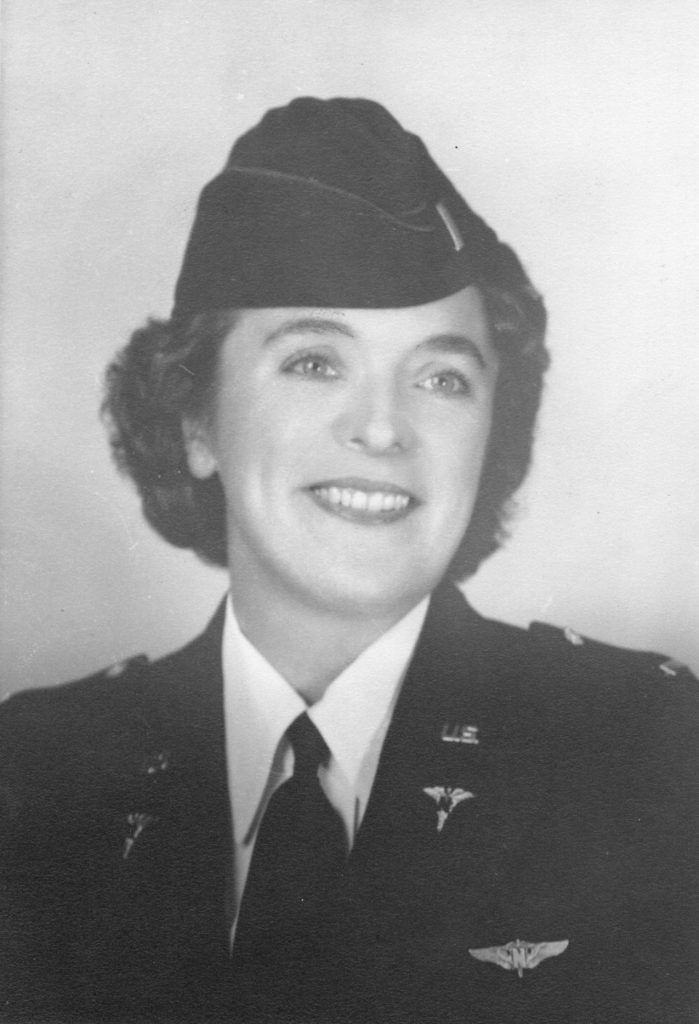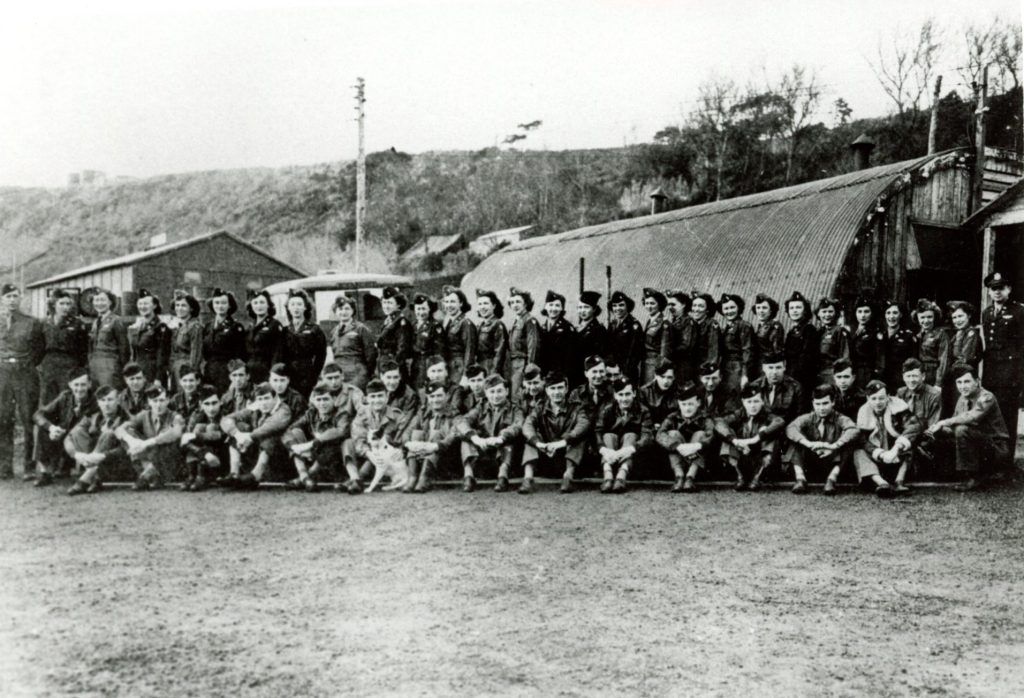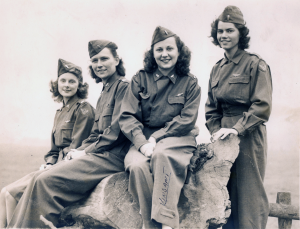The Twenty–eighth in a series of Blogs about the 31 Medical Air Evacuation
Transport Squadrons activated during WW2
to provide inflight nursing care to sick and wounded soldiers,
tended by Army flight nurses and enlisted technicians.
The focus is on the flight nurses.
Bringing Wounded Soldiers Home
828 MAETS Activated July 1944
829 MAES Activated August 1944
830 MAES Activated November 1944
831 MAES Activated November 1944
As the war entered its final years, the air evacuation system was tasked with returning increasing numbers of patients from the Pacific to the west coast of the US and with returning wounded soldiers from debarkation hospitals on US coasts to hospitals nearer to their homes. The final 4 MAES activated during WW2 provided the flight nurses and enlisted technicians to accompany these patients to their stateside destinations.
In September 1944, ATC was charged to prepare to evacuate 100 patients a week from the Pacific to the US, a requirement raised to 1,000 patients monthly by October and doubled to 2,000 by the end of that month. Because air evacuation personnel were needed in so many widely separated locations of the Pacific, the 809 MAES and 812 MAES already in theater could not handle such an extensive undertaking alone. 1
The 828 MAES was sent to Hickam Field, Oahu in August 1944 as an additional squadron in anticipation of casualties resulting from the Battle of Saipan that had concluded the previous month. From Hickam Field, 2 Flights were attached to the Central Pacific Wing and 2 Flights to the Southwest Pacific Wing, with a detachment sent to Guadalcanal. 2 Leora Stroup, who was in charge of flight nurse training at the School of Air Evacuation at Bowman Field, KY was released from that assignment and assigned to the 828 MAES for the journey overseas as were 34 additional nurses who had completed the flight nurse course. Having trained the first 1,000 AAF flight nurses, Stroup was given an opportunity to apply the training that she had coordinated beyond the class setting when she received orders for duty overseas; her ultimate position, which she assumed in December 1944, was as Chief Flight Nurse of the Pacific Division of ATC. 3

Leora B. Stroup, 1943 (AMEDD)
On 27 September 1944 shortly after arriving with the short–lived 828 MAES, flight nurse Mary Hawkins and an enlisted technician were on an air evacuation mission from Los Negros in the Admiralty Islands to Guadalcanal when poor radio communication and nonfunctioning compasses necessitated a crash landing on small Bellona Island in the Solomon Islands. The plane ran into trees, which tore off the left propeller and the left side of the fuselage. A litter pole broke from the impact, severing a patient’s trachea and causing profuse hemorrhaging and difficulty breathing. His was the only serious injury. Hawkins directed the removal of all patients from the plane to a nearby clearing, gave the critically injured patient morphine, suctioned his throat with an aesepto syringe, and used a small rectal tube to administer oxygen from the aircraft walk-around bottle until help arrived.
Meanwhile the crew had established communication with Guadalcanal, and within an hour, planes were circling overhead. Men carried the injured patient to a native hut for the night, where Hawkins and the enlisted technician alternated as attendant. The next morning a plane airdropped emergency crash kits containing plasma for the injured patient, and a Navy doctor and 2 pharmacist mates arrived from a waiting destroyer with more plasma. After the patient had been given plasma and glucose, the physician performed a tracheotomy on him. By that afternoon the injured patient, medical crew, and the other survivors of the crash had arrived at the beach, boarded the destroyer, and were on their way to Guadalcanal. Based on her experience, Hawkins recommended that all air evacuation flights carry at least 1 unit of plasma, adequate oxygen equipment, and at least 1 instrument to clamp bleeders. Squadron documents annotate that Hawkins later received the Distinguished Flying Cross and the Bronze Star in recognition of her exceptional performance during this air evacuation mission gone awry. 4
Charlotte McFall Maddon, who flew with the 828 MAES, recalled: “I flew all over the Pacific – Biak, New Guinea; Tarawa, Gilbert Islands; Leyte and Luzon, Philippines; Saipan; Tinian; Okinawa, Iwo Jima; Kwajalein and Eniwetok; Marshall Islands; Johnson [sic] Island; and Hawaii.” Her most memorable flight may have been when she transported 3 former POWs from Manila as ambulatory patients.
After they were settled, I went to the front of the plane and used the microphone: I announced to the other patients who were on litters, ‘We are honored today to have three of our prisoners of war who survived the death march.’ Everyone applauded and shouted. It was wonderful. 5
Both the 828 MAES and the 829 MAES were disbanded in November 1944 and absorbed into the 830 MAES with new Flight designations under ATC. Flights C and D of the 829 MAES that had been assigned to the Central African Division, were sent to the Pacific in October 1944. Flight nurse Jane Simmons of the 829 MAES, who later flew with Flight 22 of the 830 MAES wrote:
I can still picture the air battle we watched between American and Japanese fighter planes as we circled over Okinawa, waiting to land and pick up wounded men. We couldn’t land until the Japanese planes had been shot down, and watched from the air as the fighting continued on the ground as well. When it was clear enough for us to land, the patients we got were bloody and had barely been bandaged, they were so fresh from battle. 6
The 830 MAES grew from modest to massive in size as its number of Flights more than doubled from November 1944 to July 1945. A further anticipated increase in Flights for the invasion of Japan was not needed. By that time, lettered Flights from 13 previously activated MAES had been disbanded and their personnel incorporated – all or only designated Flights – into the 830 MAES: the 805 MAES, the 808 MAES, the 810 MAES, the 814 and 815 MAES, and the 822 through the 829 MAES. All of these MAES had been assigned or committed to ATC.

822 MAES – 830 MAES, Azores 1944 (Author’s Collection)
The 830 MAES was formed when ATC encountered difficulties from “multifold command relationships” that “gave trouble as patient airlift increased” during the war. Futrell elaborates:
Tenuous control of attached personnel complicated the scheduling of air evacuation flights. The standard medical air evacuation squadron, moreover, was designed to work in theaters of operations with troop carrier wings and it had excessive administrative overhead for an airline–type operation which primarily required flight teams. For this reason, the Air Transport Command on 21 October 1944 secured authority to disband the medical air evacuation squadrons which were assigned or committed to it [in accordance with this action, the 805, 808, and 822 through the 828 MAES were disbanded], and to activate the 830th Medical Air Evacuation Squadron. On 5 November 1944, the 830th Squadron was activated with a headquarters at Gravelly Point [Arlington], Virginia, and a total of thirty-eight flights attached to ATC wings around the world. 7
From its original 38 Flights in November 1944, the 830 MAES grew to 40 Flights by year’s end, then to 56 in April 1945 and to 78 in July 1945. V–J Day made a proposed expansion to 90 Flights unnecessary.
Since most newly absorbed MAES remained at their current duty stations, the 830 MAES had air evacuation Flights located in all the theaters of operation as well as in the US as needed. In Europe, for the Flights assigned to Prestwick, Scotland and Orly Field, France, a shuttle system ensured that air evacuation teams would not fly the entire trip from Europe to the US, but rather only one leg at a time with a 24–hour layover, and that eventually all teams would make it back to the US for a 24– to 48–hour crew rest before deadheading back to Europe. 8
In the Pacific, in December 1944 the former 828 MAES and 829 MAES now part of the 830 MAES were joined by 6 additional Flights of that squadron divided among Hickam Field, Saipan, Biak, and Guadalcanal. A rotational system similar to the one in Europe dispatched air evacuation teams to forward bases from Hickam; teams moved progressively closer to the west coast of the United States, with 24–hour rest stops at en route bases. Each team made the entire trans–Pacific run, and after a 48–hour crew rest in the US, returned to Hickam to repeat the cycle. Between June and August 1945, 15 new 830 MAES Flights arrived in Hawaii in anticipation of an invasion of Japan. 9 By the end of the war, 22 Flights were assigned to the Pacific. 10
Once wounded soldiers reached coastal hospitals in the US, their journey had not ended, for those hospitals needed to be cleared out to make room for patients arriving on forthcoming flights from overseas. The magnitude of the situation was on the minds of military planners in the spring of 1944 when 28,000 patients a month were expected to arrive on the east and west coasts, Charleston, SC and New Orleans, LA ports of debarkation, and an additional 2,000 patients would need additional air transportation within the US. 11 The increasing number of Flights in the 830 MAES allowed their assignment at stateside locations as well.
Until April 1944, with no organized system in place, domestic air evacuation of patients was dependent on locally available aircraft. When the Ferrying Division began operating military airlines within the US that month, ATC allocated aircraft to the Ferrying Division for air evacuation, and the School of Air Evacuation at Bowman Field sent Flights on Detached Service to Ferrying Division bases at Wilmington, DE and Memphis, TN as medical attendants to the patients. Debarkation hospitals were identified along the US coasts where patients arriving from overseas were screened to determine their definitive treatment needs at hospitals nearest to their homes – a policy abandoned in January 1945 due to an increased number of patients arriving in the US. 12
In May and June 1944, 2 Flights were assigned at Wilmington, DE and Memphis, TN and 2 each assigned to Romulus MI and Palm Springs CA. With additional C–47s available for air evacuation duty, additional MAES Flights were added. By December 1944, 3 Flights were based at Wilmington, 3 at Romulus, 6 at Memphis, and 4 at Palm Springs. Many of the nurses had rotated home from overseas air evac duty. In 1945, Flights of the 830 MAES were transferred to additional bases nearer the principal debarkation hospitals – Stockton Army Airfield, CA and Fort Dix AAB, NJ; 3 additional 830 MAES Flights were activated at Fort Dix. 13
Additional C–47s for the Ferrying Division required additional flight nurses; following a short course at the School of Aviation Medicine at Randolph Field, TX, 97 flight nurses arrived in July 1945 for 3 weeks of post–graduate training at Fort Dix, Romulus and Stockton. When these nurses were organized into units, the 830 MAES possessed 30 domestic Flights – 15 at Fort Dix, 4 at Long Beach, CA, and 11 at Stockton. 14
To highlight the scope of domestic air evacuation, Futrell notes that between 19 April 1944 and 30 September 1945, up to 153 flight nurses and 120 enlisted technicians flying missions with ATC evacuated over 103,000 patients within the US. June 1945 had the largest monthly total of over 11,000 patients transported on domestic air evacuation missions. 15
The 831 MAES was one of the 3 original squadrons sent to the Pacific, where the 809 MAES and 812 MAES already were evacuating patients. The last of the 31 MAES, activated in November 1944, at least some of the 831 MAES flight nurses were trained at the School of Aviation Medicine, Randolph Field, TX, the new location for the course after the AAF School of Air Evacuation at Bowman Field closed in October 1944. The 831 MAES arrived in the Pacific in January 1945, and Flights C and D were dispatched to Guam. 16 The squadron had a year of flying in its original designation before it, the 809 MAES, and the 812 MAES were disbanded and reformed as Flights in the 830 MAES. 17
For more about Leora Stroup, see Beyond the Call of Duty: Army Flight Nursing in World War II, Chapter 3.
Notes
- Robert F. Futrell, Development of Aeromedical Evacuation in the USAF, 1909–1960, Historical Studies No. 23 (Maxwell AFB, AL: USAF Historical Division, Research Studies Institute, Air University; Manhattan, KS: Military Affairs / Aerospace Historian, 1960), 416; “Headquarters 809th Med Air Evac Squadron APO 953 Squadron History Month of September 1944”. [AFHRA MED–809–HI]
- Futrell, Aeromedical Evacuation, 406–407.
- “Army Air Forces School of Air Evacuation, Bowman Field, Louisville, Kentucky Special Orders Number 141”, 3 Jul 1944. [AFHRA MED–828–HI]; “Trumbull Woman Heads Nurses Doing Air Evacuation of Pacific Wounded”, Ohio Nurses Review 2 (Oct 1945): 168; “30 Pairs of Eyes Follow Nurse Across Ocean”, New York Telegram, 11 May 1945; John R. McGraw, “Flight Nurse Designation”, letter to Commanding Officer, 828 MAES, 9 Nov 1944; “Special Orders No. 25 Extract”, Air Transport Command, 1503rd AAF Base Unit, Pacific Division, Port of Aerial Embarkation, Hamilton Field, California, 26 August 1944”; “Special Orders Number 122 Extract”, Headquarters Pacific Division, (1500th Air Base Unit), AAF Air Transport Command, APO #953”, 12 Dec 1944. [AMEDD]
- “A Makeshift Windpipe”, Trained Nurse and Hospital Review 114 (3) (Mar 1945): 197; “Man With Throat Cut Saved by Army Nurse”, New York Times, 28 Dec 1944 [AMEDD]; George W. Jones, “Excerpt from Statement of Lt Jones – Pilot of C-47 #236, 29 September 44”; Mary L. Hawkins, “Statement of Mary L. Hawkins, 2nd LT, ANC (N–737974)”; Kermit H. Anderson, “Recommendation for Award of Distinguished Flying Cross” with annotation “given”, 29 May 1945; Kermit H. Anderson, “Recommendation for Award of Soldier’s Medal” with annotation “given Bronze Star instead”, 29 May 1945. [AMEDD]
- Diane Burke Fessler, No Time for Fear: Voices of American Military Nurses in World War II (East Lansing: Michigan State University Press, 1996), 70, 74.
- Ibid., 74.
- Futrell, Aeromedical Evacuation, 363.
- Ibid., 387–88.
- Ibid., 417.
- Mae M. Link and Hubert A. Coleman, Medical Support of the Army Air Forces in World War II (Washington, DC: US Government Printing Office, 1955), 402.
- Futrell, Aeromedical Evacuation, 440.
- Ibid., 444.
- Ibid., 441, 449.
- Ibid., 457.
- Ibid., 458.
- Ibid., 417, 421.
- “Discontinuance and Reestablishment of AAF School of Air Evacuation”, War Department Letter AG 352 (30 Sep 1944), War Department, The Adjutant General’s Office, Washington, DC, 2 Oct 1944. [AFHRA 280.93–20 v.1]



I was wondering if you had any rosters of the personnel in the 830th, while not a Nurse I am fairly certain my grandfather was in this unit. If you have any information please contact me.
Hello Sean, and thank you for visiting my website. Unfortunately, I have not come across any rosters of personnel in the 830th Medical Air Evacuation Squadron (MAES). The files that I have about that squadron do not list any names. I’m sorry that I can’t help you learn more about your grandfather’s possible assignment in that squadron. It was activated 5 November 1944 and drew its personnel from MAES activated earlier in the war, so he might have been in a different numbered MAES first before he was assigned to the 830 MAES. All best in your research.